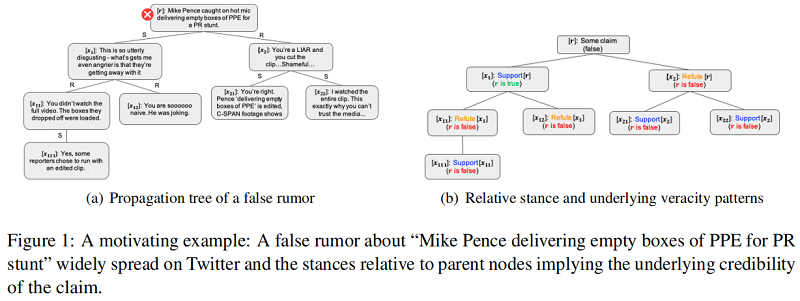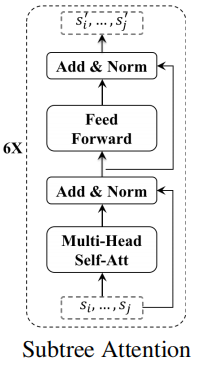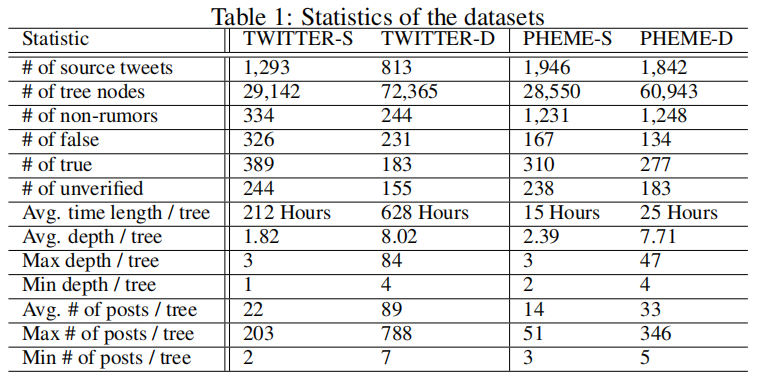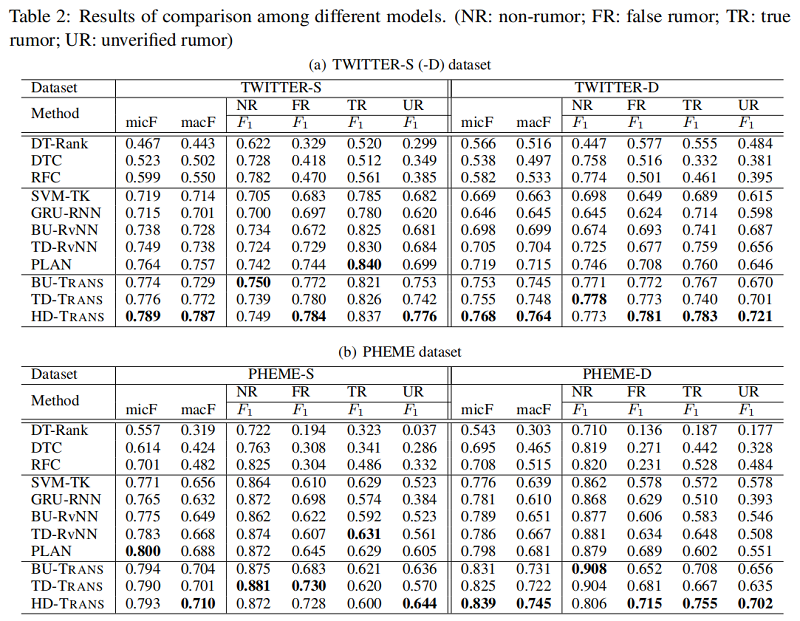论文信息
论文标题:Debunking Rumors on Twitter with Tree Transformer论文作者:Jing Ma、Wei Gao论文来源:2020,COLING论文地址:download 论文代码:download
1 Introduction
出发点:Existing conversation-based techniques for rumor detection either just strictly follow tree edges or treat all the posts fully-connected during feature learning.
创新点:Propose a novel detection model based on tree transformer to better utilize user interactions in the dialogue where post-level self-attention plays the key role for aggregating the intra-/inter-subtree stances.
例子:以 PLAN 模型为例子——一种帖子之间全连接的例子

结论:Post 之间全连接的模型只适合浅层模型,并不适合深层模型,这是由于 Post 一般只和其 Parent 相关吗,全连接导致 Post 之间的错误连接加重。
2 Tree Transformer Model

2.1 Token-Level Tweet Representation
Transformer encoder 框架:

给定一条表示为 word sequence $x_{i}=\left(w_{1} \cdots w_{t} \cdots w_{\left|x_{i}\right|}\right)$ 的推文,每个 $w_{t} \in \mathbb{R}^{d}$ 是一个 $d$ 维向量,可以用预先训练的单词嵌入初始化。我们使用多头自注意网络(MH-SAN)将每个 $w_{i}$ 映射到一个固定大小的隐藏向量中。MH-SAN 的核心思想是共同关注来自不同位置的不同表示子空间的单词。更具体地说,MH-SAN 首先将输入字序列 $x_i$ 转换为具有不同线性投影的多个子空间:
其中,$\left\{Q_{i}^{h}, K_{i}^{h}, V_{i}^{h}\right\}$ 分别为 query、key 和 value representations,$\left\{W_{Q}^{h}, W_{K}^{h}, W_{V}^{h}\right\} $ 表示与第 $h$ 个头关联的参数矩阵。然后,应用 attention function 来生成输出状态。
$O_{i}^{h}=\operatorname{softmax}\left(\frac{Q_{i}^{h} \cdot K_{i}^{h^{\top}}}{\sqrt{d_{h}}}\right) \cdot V_{i}^{h} \quad\quad\quad(2)$
其中,$\sqrt{d_{h}}$ 是 放缩因子,$d_{h}$ 表示第 $h$ 个头的子空间的维数。最后,表示的输出可以看作是所有头 $O_{i}=\left[O_{i}^{1}, O_{i}^{2}, \cdots, O_{i}^{n}\right] \in \mathbb{R}^{\left|x_{i}\right| \times d}$ 的连接,$n$ 为头数,然后是一个归一化层(layerNorm)和前馈网络(FFN)。
$\begin{array}{l}B_{i}=\operatorname{layerNorm}\left(O_{i} \cdot W_{B}+O_{i}\right) \\H_{i}=\operatorname{FFN}\left(B_{i} \cdot W_{S}+B_{i}\right)\end{array} \quad\quad\quad(3)$
其中 $H_{i}=\left[h_{1} ; \ldots ; h_{\left|x_{i}\right|}\right] \in \mathbb{R}^{\left|x_{i}\right| \times d}$ 是表示 tweet $x_i$ 中所有单词的矩阵,$W_{B}$ 和 $W_{h}$ 包含 transformation 的权值。最后,我们通过 maxpooling 所有相关 words 的向量,得到了 $x_i$ 的表示:
$s_{i}=\max -\operatorname{pooling}\left(h_{1}, \ldots, h_{\left|x_{i}\right|}\right) \quad\quad\quad(4)$
其中,$s_{i} \in \mathbb{R}^{1 \times d}$ 为 $d$ 维向量,$|\cdot|$ 为单词数。
2.2 Post-Level Tweet Representation
(1) posts are generally short in nature thus the stance expressed in each node is closely correlated with the responsive context;
(2) posts in the same subtree direct at the individual opinion expressed in the root of the subtree.
Figure 2(c) 说明了本文的 tree transformer 结构,它 cross-check 从底部子树到上部子树的 post。具体来说,给定一个有根于 $x_j$ 的子树,假设 $\mathcal{V}(j)=\left\{x_{j}, \ldots, x_{k}\right\}$ 表示子树中的节点集合,即 $x_j$ 及其直接响应节点。然后,我们在 $\mathcal{V}(j)$ 上应用一个 post-level subtree attention(a transformer-based block as shown in Figure 2(b)),以得到 $\mathcal{V}(j)$ 中每个节点的细化表示:
$\left[s_{j}^{\prime} ; \ldots ; s_{k}^{\prime}\right]=\operatorname{TRANS}\left(\left[s_{j} ; \ldots ; s_{k}\right], \Theta_{T}\right) \quad\quad\quad(5)$
其中,$TRANS (\cdot)$ 是具有如 Eq. 2-4 中所示的相似形式的 transform function,$\Theta_{T}$ 包含了 transformer 的参数。因此,$s_{*}^{\prime}$ 是基于子树的上下文得到的 $s_{*}$ 的细化表示。请注意,每个节点都可以被视为不同子树中的父节点或子节点,例如,在 Figure 2(a) 中,$x_{2}$ 可以是 $T\left(x_{2}\right)$ 的父节点,也可以是 $T(r)$ 的子节点。因此,一部分的节点在我们的 from bottom subtree to upper subtree 模型中结果两次层次细化:(1)通过与父节点相比来捕获立场 stance,(2) 通过关注邻居节点来获得较低权重的不准确信息,例如,一个父母支持一个错误的声明可能会细化如果大多数响应驳斥父节点。
Top-down transformer 的方向与 bottom-up transformer 相反,沿着信息传播的方向,其架构如 Figure 2 (d) 所示。同样的,其学习到的表示也通过捕获立场和自我纠正上下文信息得到增强。
2.3 The overall Model
为了共同捕获整个树中表达的观点,我们利用一个注意力层来选择具有准确信息的重要帖子,这是基于细化的节点表示而获得的。这将产生:
$\begin{array}{l}\alpha_{i}=\frac{\exp \left(s_{i}^{\prime} \cdot \mu^{\top}\right)}{\sum\limits_{j} \exp \left(s_{j}^{\prime} \cdot \mu^{\top}\right)} \\\tilde{s}=\sum\limits_{i} \alpha_{i} \cdot s_{i}^{\prime}\end{array}\quad\quad\quad(6)$
其中,$s_{i}^{\prime}$ 由 Bottom-Up Transformer 或 Top-Down Transformer 得到,$\mu \in \mathbb{R}^{1 \times d}$ 是注意力机制的参数。这里的 $\alpha_{i}$ 是节点 $x_i$ 的注意权值,用于生成整个树的表示 $\tilde{s}$。最后,我们使用一个全连接的输出层来预测谣言类上的概率分布。
$\hat{y}=\operatorname{softmax}\left(V_{o} \cdot \tilde{s}+b_{o}\right) \quad\quad\quad(7)$
其中,$V_{o}$ 和 $b_{o}$ 是输出层中的权值和偏差。
此外,还有一种直接的方法可以将 Bottom-Up transformer 与 Top-Down transformer 的树表示连接起来,以获得更丰富的树表示,然后将其输入上述的 $softmax (\cdot)$ 函数进行谣言预测。
我们所有的模型都经过训练,以最小化预测的概率分布和地面真实值的概率分布之间的平方误差:
$L(y, \hat{y})=\sum_{n=1}^{N} \sum_{c=1}^{C}\left(y_{c}-\hat{y}_{c}\right)^{2}+\lambda\|\Theta\|_{2}^{2} \quad\quad\quad(8)$
其中 $y_{c}$ 是 ground-truth label ,$\hat{y}_{c}$ 是类C的预测概率,$N$ 是训练的树数,C 是类的数量,$\|.\|_{2}$ 是所有模型参数 $\Theta$ 上的 $L_{2}$ 正则化项,$\lambda$ 是权衡系数。
3 Experiments
使用 TWITTER 和 PHEME 数据集进行实验,按照传播树深度将两个数据集划分为 TWITTER-S (PHEME-S)和 TWITTER-D (PHEME-D) 一共4个数据集,下表展示数据集的统计情况:

Experiment

Early Rumor Detection Performance

标签: # 谣言检测

留言评论